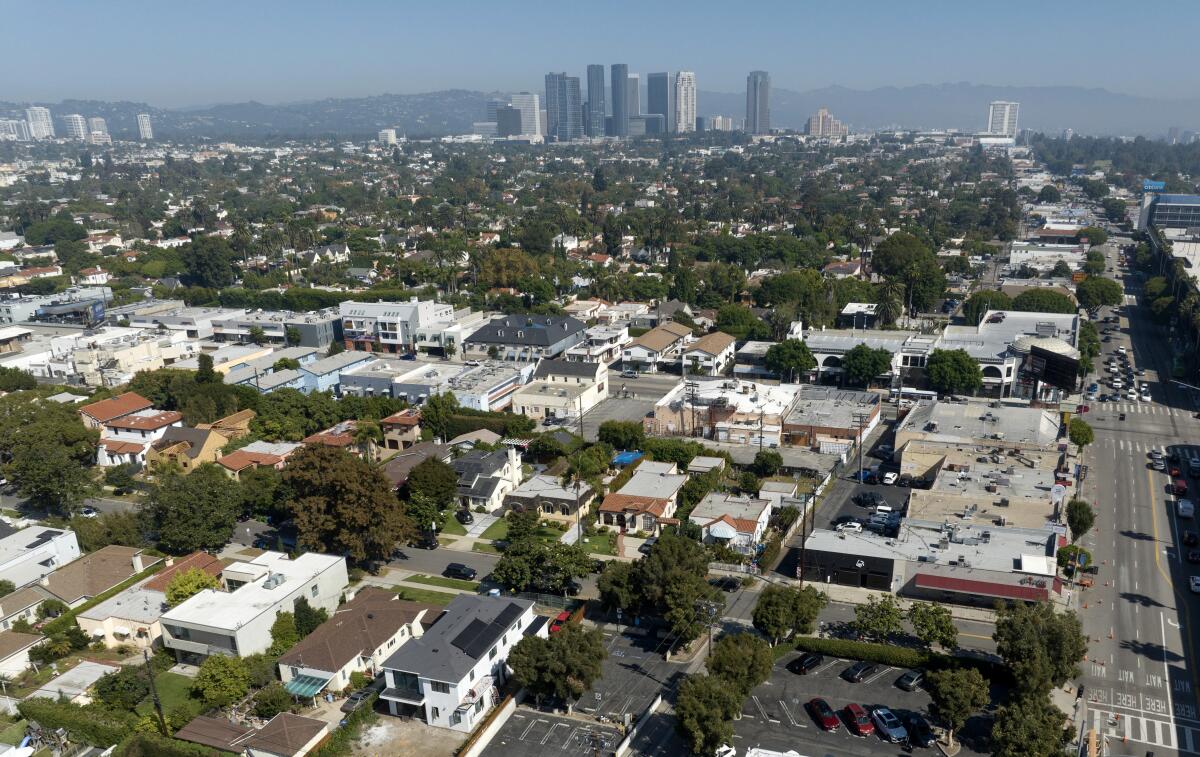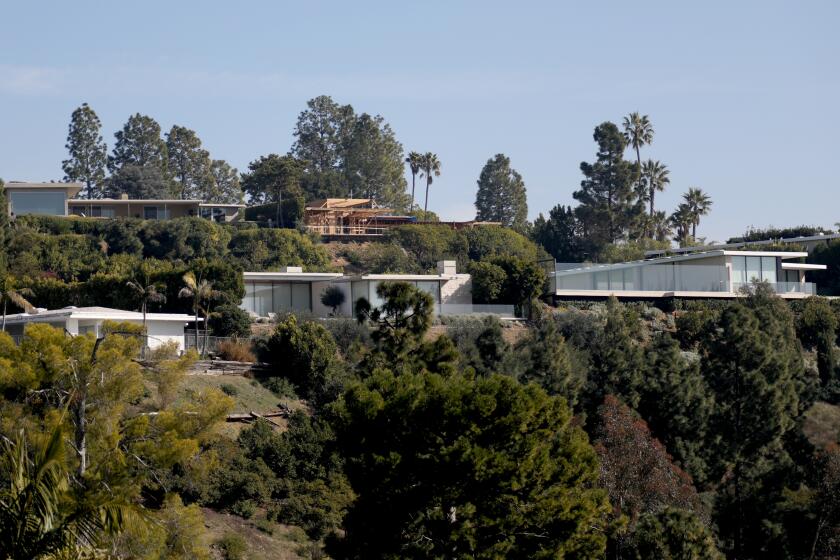Los Angeles has to rezone the entire city. Why are officials protecting single-family-home neighborhoods?

- Share via
The city of Los Angeles is on the verge of redrafting blueprints for its neighborhoods to accommodate more than 250,000 new homes. But under a recommendation from the planning department, nearly three quarters of the city will remain off limits to further growth.
At stake is no less than a vision for Los Angeles’ future. Will L.A. continue to preserve communities dominated by single-family homes? Or will the city make a historic shift to allow for more affordable housing in areas that have long excluded it?
The department’s proposal leaves alone neighborhoods that allow only for the building of single-family homes — as well as accessory dwelling units in many cases — a classification that represents 72% of the residential land in L.A. Instead, the department is pushing for the city to meet the 250,000-unit production goal through incentives for greater development in existing multifamily and commercial areas.
The city Planning Commission is scheduled to vote on the proposal Thursday. The City Council must approve a final plan in advance of a February state deadline.
Keeping single-family home neighborhoods untouched maintains the low-density character that, as much as any big U.S. city, has defined modern Los Angeles and responds to advocacy from homeowner groups who want to maintain their neighborhoods as they are. But some social justice and housing groups say that doing so will fortify longstanding inequalities in L.A.’s housing market in the face of an ongoing affordability crisis.
More homes are overcrowded in L.A. than in any other large U.S. county, a Times analysis of census data found — a situation that has endured for three decades.
A newly released city-funded report, more than three years in the making, bolsters critiques of so much single-family-home zoning.
The 124-page study, which the planning department initially refused to disclose to The Times through a public records request, calls the century-old zoning designation a key factor in maintaining current racial and economic disparities and one that originated as a means of advancing the interests of white-led real estate and homeowner groups. The city awarded a contract to write the report in July 2021, and published it last week after The Times argued that its withholding was unlawful.
“Past planning and housing policies have too often prioritized the concerns of the White middle class over the marginalized, denying communities of color access to resources and excluding them from wealth-building opportunities,” reads the report, which was written by the firm Architectural Resources Group and academics affiliated with UCLA and USC. “Exclusionary policies of the past persist today, perpetuating patterns of segregation, displacement, inequity, and exclusion.”
The report noted that more than 80% of L.A.’s land with the highest-performing schools, most public amenities and best access to jobs is zoned only for single-family homes. In a smaller slice that captures the wealthiest neighborhoods that are majority white, 95% of residentially zoned land is exclusively for single-family homes.
“Detached single-family residences cover a disproportionate amount of the land zoned residential,” the report says. “This has resulted in an unaffordable housing market due, in part, to a pervasive lack of supply and the fact that single-family homes are more expensive than multi-family residences.”
The future of single-family-home neighborhoods has been one of the most contentious issues in the citywide rezoning discussions, an effort required every eight years under state law. New regulations are forcing cities to plan for a lot more housing than before and to shift development toward richer areas that have long resisted it.
After an hour of debate, Herb Perez had had enough.
The city’s initial November 2021 proposal committed to looking into allowing some low-income housing in single-family home areas near mass transit and in wealthier neighborhoods. The plan would have let property owners build multifamily housing. Last fall, pushback from homeowner groups, which argued that the city should instead prioritize development along commercial corridors, led the city to decide that it wouldn’t change the single-family-home areas.
The planning department’s current recommendation maintains these neighborhoods as they are, save for the 1% of land zoned for single-family homes that is owned by public agencies or faith-based organizations that could build limited affordable housing. But in its report to the Planning Commission, the department lists options to allow low-income housing in single-family-home areas should commissioners or City Council members want it.
Under the recommended plan, 56% of growth would be targeted in higher-resourced multifamily or commercial areas of L.A., a percentage the planning department expects will meet state requirements. If some single-family neighborhoods in Mid-City, the Westside and San Fernando Valley, for instance, were included in the zoning changes, higher-resourced communities would receive more than two-thirds of the projected new housing, the department said.
Planning department spokesperson Nora Frost said officials included the different options “given the importance of the issue and considerable public debate.”
The department’s report noted that it had received about 3,000 comments addressing the status of single-family neighborhoods in the rezoning plan, with more than three-fourths opposed to making changes. At the same time, some housing advocacy groups are campaigning for new rules.
Mahdi Manji, director of public policy at the Inner City Law Center, said that by not allowing affordable housing in the single-family areas, the rezoning proposal is “playing at the edges” of integrating communities.
Nearly two-thirds of homes in L.A. are renter-occupied, U.S. census data show. By concentrating housing production where tenants already live, the city is asking them to bear the brunt of growth since developers will have to tear down small, often rent-controlled apartment complexes, and replace them with larger ones, Manji said.
“The argument is that the majority of the residents need to accept a greater disruption to their lives so the minority of residents, who are disproportionately wealthier and whiter, can continue to keep their neighborhood as it is,” Manji said.
Last month, a Los Angeles County Superior Court judge issued a moratorium on building permits in Beverly Hills as punishment for the city not passing a blueprint for sufficient affordable housing.
The intensity of these conversations has led planning officials to say that they should continue after the rezoning effort is complete, Frost said. She noted that it took Minneapolis and Portland, Ore., at least five years to tailor affordable housing incentives in areas that previously were solely for single-family-homes.
“The city should engage further with Angelenos and reach a consensus that prioritizes housing equity while moving the needs of the city forward,” Frost said.
The city-funded study was intended to be part of the rezoning debate. In May 2021, the city asked consultants to document the historical role of planning in creating and furthering housing inequities. The study was expected to cost $60,000 and be finished by August 2021, before the city’s first submission of its broad rezoning plans to the state.
But the process dragged out as city planners made multiple revisions to report drafts. In December 2022, the city increased the contract amount to $124,480 and asked the consultant to make final changes.
This month, more than three years after the study was supposed to be completed, the planning department denied a Times request for the report. The department said that even though the consultants had finished, planning staff was “working to prepare an outreach plan for the study” and therefore it was exempt from release to safeguard agency deliberations. On Sept. 20, after the Times protested the withholding, the department published the document on its website.
The study calls Los Angeles “a pioneer” in the early 20th century in creating districts for only single-family homes that, when combined with racially restrictive covenants, mortgage redlining and other policies, ensured that white residents often had sole access to good housing. Planning practices in the second half of the 20th century were less explicit in efforts to bar poor and nonwhite residents, the report said, but have reinforced existing patterns of exclusion.
Starting in the 1970s, the report said, the city downzoned large swaths of land, reducing building allowances that would have let the city accommodate enough homes for 10 million people to 4 million, and further empowered homeowner groups in the planning process.
The study calls the 1972 development blueprint for Westwood “a useful case study for how zoning rollback fostered economic inequality.” The Westwood plan set aside 435 acres for multifamily housing intended for 51,000 people and 1,000 acres for single-family housing for 14,000 people. It required any future density increases to be paired with reductions elsewhere in the neighborhood. These constraints have limited housing opportunities and raised costs for the growing numbers of students and staff at UCLA’s Westwood campus, the study concluded.
“The Community Plan essentially captured multiple acres for properties used by wealthier households, excluding that land from higher-density development and preventing future changes that could be needed to address a housing shortage,” the report said.
Although the city has updated the Westwood plan over the last 50 years, the study said, many of its core components are unchanged.
More to Read
Sign up for This Evening's Big Stories
Catch up on the day with the 7 biggest L.A. Times stories in your inbox every weekday evening.
You may occasionally receive promotional content from the Los Angeles Times.








